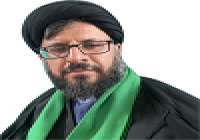The Hadith Thaqalayn
The Hadith Thaqalayn
Zayd ibn Arqam said: One day the Messenger of Allah (S.A.W.) rose to preach among us near a ditch called Khum in midway between Makkah and Madinah. He praised and adored Allah gave admonitions, preached, and then said: O people! I am a man too; to whom will soon come a herald from my Lord and I too will have to follow. I leave among you two "Weights": The first is the Book of Allah in which lies guidance and light, so take hold of the Book of Allah and cling to it firmly. Then having recommended and encouraged the Book of Allah, The Holy Prophet (S.A.W.) said: And my Ahl al-Bayt, I remind you of Allah for my Ahl al-Bayt, I remind you of Allah for my Ahl al-Bayt, I remind you of Allah for my Ahl al-Bayt.
The messenger of Allah (S.A.W.): I have left among you something to which as long as you cling, you will never be astrayed after me: one is greater than the other: The Book of Allah which is a string hung from the heaven to the earth, and my Itrat, my Ahl al-Bayt.
These two will never separate from each other until they join me at the pond of Kawthar: so be careful as to how you behave toward them in my absence.
Al-Imam Ali (A.S.) said: Verily the Exalted Allah made us pure and infallible, held us witness to his creatures, assigned us as his authority on the earth, placed us next to the Holy Qur'an and the Holy Qur'an next to us, neither do we separate from it, nor it will separate from us.
Zayd ibn Ali quoting al-Imam Ali (A.S.) on the authority of his ancestors: As the Holy Prophet's (S.A.W.) illness became more serious and the house was crowded with people, he said: Bring al-Hasan (A.S.) and al-Husayn (A.S.) to me. I called them in. The Holy Prophet (S.A.W.) kissed them so much that he fell unconscious. Zayd ibn Ali says: Al-Imam Ali (A.S.) took the two off the Holy Prophet's (S.A.W.) face. He adds: The Holy Prophet (S.A.W.) opened his eyes and said: Let these two take benefit from me and I from them; after my demise these two will receive atrocities. Then he said: O people! I leave among you the Book of Allah, my tradition, my Itrat and my Ahl al-Bayt [as reminders],whoever ruins the Book of Allah, has actually ruined my tradition and whoever ruins my tradition has ruined my Itrat, take heed that these never separate from each other until join me at the pond of Kawthar.
Hisham ibn Hassan: I heard al-Hasan Mujtaba(A.S.) recite a sermon(khutbah) after his allegiance for caliphate and said: We are the dominant party of Allah and the close household to the Holy Prophet(S.A.W.) and his pure and spotless Ahl al-Bayt and one of the two weights which the Messenger of Allah (S.A.W.) has left among his Ummah, the second being the Book of Allah in which details of everything are brought up and no falsity has way into it at all. In its interpretation, certainty is with us, and in its tawil we are in no doubt, rather certain about its facts.
A. The Document of Hadith Thaqalayn:
The Hadith Thaqalayn by which the Holy Prophet of Islam (S.A.W.) introduced his Ahl al-Bayt as a peer and equal to the Holy Qur'an, encouraging the Ummah emphatically to cling to them, is widely transmitted and unanimously agreed upon by narrators and Muhaddiths throughout the world of Islam. Based on studies made so far, this hadith has been narrated from the Messenger of Allah (S.A.W.) by thirty three of his companions whose names are respectively as follows: Abu Ayyub Ansari, Abu Dharr al-Ghaffari, Abu Rafi retainer of the Holy Prophet(S.A.W.), Abu Said Khudri, Abu Shurayh Khuzai, Abu Qudamah Ansari, Abu Layla Ansari, Abu al-Haytham ibn al-Tayyahan, Abu Hurayra, Umm Salama, Umm Hani, Anas ibn Malik, Bra' ibn Azib, Jabir ibn Abd Allah Ansari, Jabir ibn Mutam, Hudhayfat ibn Usayd Ghaffari, Hudhayfat ibn al-Yaman, Khuzaymat ibn Thabit Dhul Shahadatayn, Zaid ibn Arqam, Zaid ibnThabit, Sad ibn Abi Waqqas, Salman Farsi, Sahl ibn Sad Damrat al-Aslami,Talhat ibn Ubayd Allah Tamimi Amir ibn Layla Abd al-Rahman ibn Awf, AbdAllah ibn Hantab, Abd Allah ibn Abbas, Udayy ibn Hatam, Aqabat ibn Amir,Umar ibn Khattab, Amr ibn al-As. These Hadiths are additional to the Hadiths quoted from the Holy Prophet (S.A.W.) by al-Imam Ali(A.S.) and other members of Ahl al-Bayt.
Similarly, the author of Abaqat al-Anwar has mentioned the names of nineteen of the followers (Tabiun) and over three hundred scholars and renowned memorizers of Hadith from among the Sunnis from second to fourteenth centuries respectively and according to their collection of biographies who have all narrated this hadith.
B. the Date and the Occasion on Which the Hadith was stated:
Research on the date of stating and the occasion on which the Holy Prophet of Islam(S.A.W.) stated this hadith indicated the Holy Prophet of Islam(S.A.W.)had on various occasions emphasized on this important socio-political issue to which the of the Islamic community is related. These occasions are as follows:
First: on the Hajj al-Wida (Farewell Pilgrimage) on the Day of Arafah.
Second: In the Mosque of Kheef.
Third: On the Hajj al-Wida in Ghadir Khumm.
Fourth: In a sermon his holiness delivered on the Minbar (pulpit)
Fifth: At his [the Holy Prophet's (S.A.W.)] ailment while the room was packed with people.
Ibn Hajar says: Be informed that the hadith of Tamassuk [Thaqalayn] has been quoted from over twenty companions in numerous ways which have formerly been discussed in details; some having reported that it was stated on the Hajjal-Wida and on the Day of Arafah, and others contending it was expressed on his sickbed in Madinah while his room was packed with his companions; still others believe that the hadith was told in Ghadir-i Khumm, but some others assert that it was related in a sermon upon his return from Ta'if. As it was said, none of the above refutes the others, because there is no objection to it that the Holy Messenger (S.A.W.) had reiterated the hadith on these occasions to highlight the dignity of the noble Book and the pure Itrat.
Source: The Image of Ahl al-Bayt (A.S.) in The Qur'an and Hadith
By: Muhammadi Rayshahri










